Evaluating Potential Respiratory Benefits of Forest-Based Experiences: A Regional Scale Approach
Abstract
:1. Introduction
2. Materials and Methods
2.1. The Research Area
2.2. The Resource Based Theory
2.3. Data Adopted
2.3.1. Data on Administrative Boundaries and Territorial Surfaces
2.3.2. Data on Forest Tree Species, Forest Distribution, and Types
2.4. The Hollerith Distance
2.5. Assessing (Rating) Functional Potentials of Tree Species for Forest Therapy Purposes
2.5.1. Hollerith Distance: The ‘Holistic’ Model of Analysis HD1
2.5.2. Hollerith Distance: The Atomistic-Particular Analysis Model HD2
2.5.3. Hollerith Distance: The ‘Dynamic-Relational’ Approach HD3
2.5.4. Rating Functional Discrepancies of the 47 Tree Species by Applying the Hollerith Distance
2.5.5. Assessing the Potential Respiratory Benefits of the 80 Forest Types
2.6. The Ranking Process of the Rated Data
- conversion of geospatial data from the cartographic to tabular form
- data processing
- geographic referencing results
3. Results and Discussion
3.1. Healing Potential of BVOCs Emitted by Regional Forests: General-Holistic Approach (P1)
3.2. Particular-Segmentary Approach (P2)
3.3. Dynamic-Relational Approach (P3)
3.4. The Overall Potentials
4. Discussion
5. Conclusions
Author Contributions
Funding
Data Availability Statement
Acknowledgments
Conflicts of Interest
Appendix A
Appendix A.1
| Family | Genus | Species | Common Name |
|---|---|---|---|
| Pinaceae | Abies Lam | Abies alba | European silver fir |
| Sapindaceae | Acer | Acer campestre | Field maple |
| Sapindaceae | Acer | Acer monspessolanum | Montpellier maple |
| Sapindaceae | Acer | Acer platanoides | Norway maple |
| Sapindaceae | Acer | Acer pseudoplatanus | Sycamore maple |
| Betulaceae | Alnus | Alnus glutinosa | Common alder |
| Betulaceae | Alnus | Alnus incana | Grey alder |
| Betulaceae | Betula | Betula alba | White birch |
| Betulaceae | Betula | Betula pendula | Silver birch |
| Betulaceae | Carpinus | Carpinus betulus | European hornbeam |
| Betulaceae | Carpinus | Carpinus orientalis | Oriental hornbeam |
| Fagaceae | Castanea | Castanea sativa | Sweet chestnut |
| Cannabaceae | Celtis | Celtis australis | European nettle tree |
| Fagaceae | Fagus | Fagus sylvatica | Common beech |
| Oleaceae | Fraxinus | Fraxinus excelsior | Common ash |
| Oleaceae | Fraxinus | Fraxinus ornus | south European flowering ash |
| Oleaceae | Fraxinus | Fraxinus oxycarpa | Southern Ash tree |
| Pinaceae | Larix | Larix decidua | European larch |
| Betulaceae | Ostrya | Ostrya carpinifolia | European hop-hornbeam |
| Pinaceae | Picea | Picea abies | European spruce |
| Pinaceae | Pinus | Pinus halepensis sub. Brutia | Turkish pine |
| Pinaceae | Pinus | Pinus halepensis | n.a. |
| Pinaceae | Pinus | Pinus nigra | black pine |
| Pinaceae | Pinus | Pinus pinaster | cluster pine |
| Pinaceae | Pinus | Pinus pinea | Italian stone pine |
| Pinaceae | Pinus | Pinus sylvestris | Scots pine |
| Salicaceae | Populus | Populus alba | Silver poplar |
| Salicaceae | Populus | Populus nigra | Black poplar |
| Salicaceae | Populus | Populus tremula | Quaking aspen |
| Rosaceae | Prunus | Prunus avium | Sweet cherry |
| Rosaceae | Prunus | Prunus mahaleb | Rock cherry |
| Rosaceae | Prunus | Prunus padus | Hackberry |
| Fagaceae | Quercus | Quercus cerris | Turkey oak |
| Fagaceae | Quercus | Quercus ilex | Evergreen oak |
| Fagaceae | Quercus | Quercus petraea | Cornish |
| Fagaceae | Quercus | Quercus pubescens | Downy oak |
| Fagaceae | Quercus | Quercus robur | Common oak |
| Fabaceae | Robinia | Robinia pseudoacacia | Black locust |
| Rosaceae | Sorbus | Sorbus aria | Common whitebeam |
| Rosaceae | Sorbus | Sorbus aucuparia | Mountain ash |
| Rosaceae | Sorbus | Sorbus domestica | Sorb tree |
| Rosaceae | Sorbus | Sorbus torminalis | Wild service tree |
| Taxaceae | Taxus | Taxus baccata | Common Yew |
| Malvaceae | Tilia | Tilia cordata | Small-leaved lime |
| Malvaceae | Tilia | Tilia platiphillos | Large-leaved lime |
| Ulmaceae | Ulmus | Ulmus glabra | Scots elm |
| Ulmaceae | Ulmus | Ulmus minor | Field elm |
Appendix A.2. Potentials of Forest Types
Appendix A.2.1. Potential Respiratory Impacts—P1 Model
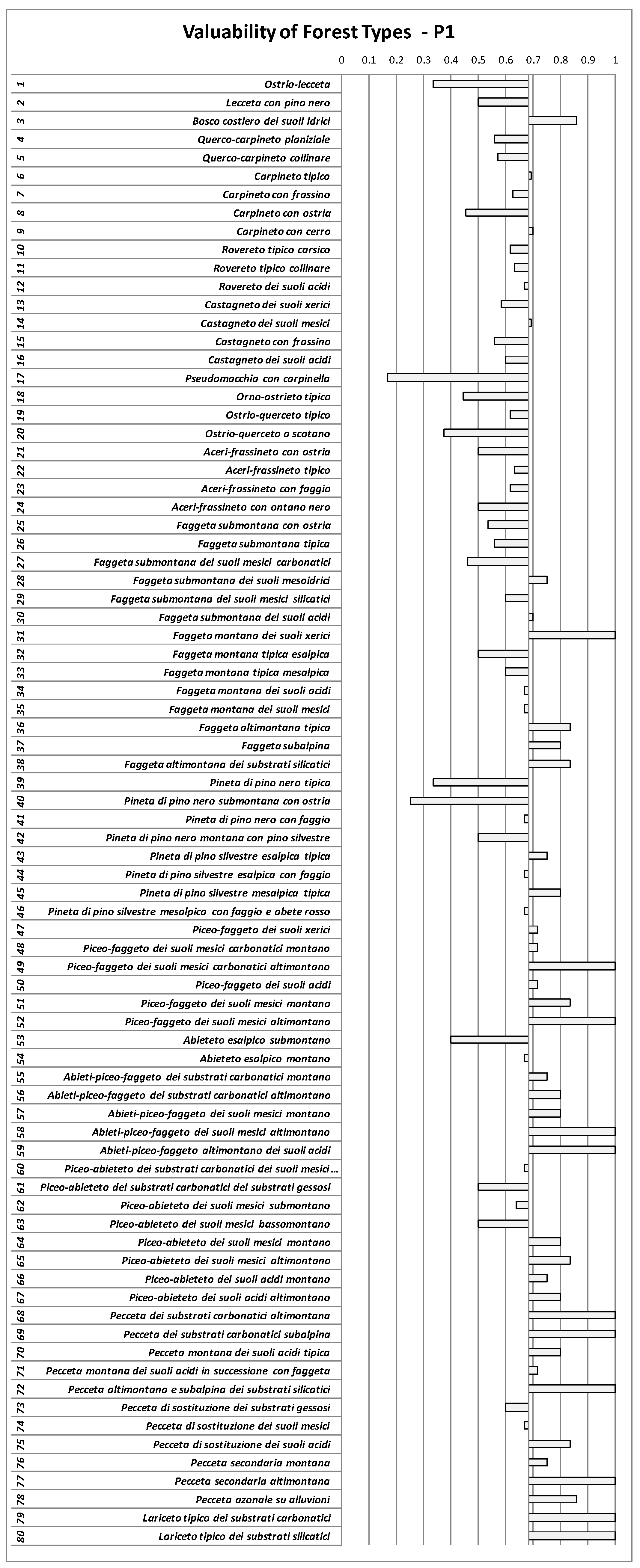
Appendix A.2.2. Potential Respiratory Impacts—P2 Model

Appendix A.2.3. Potential Respiratory Impacts—P3 Model

Appendix A.3
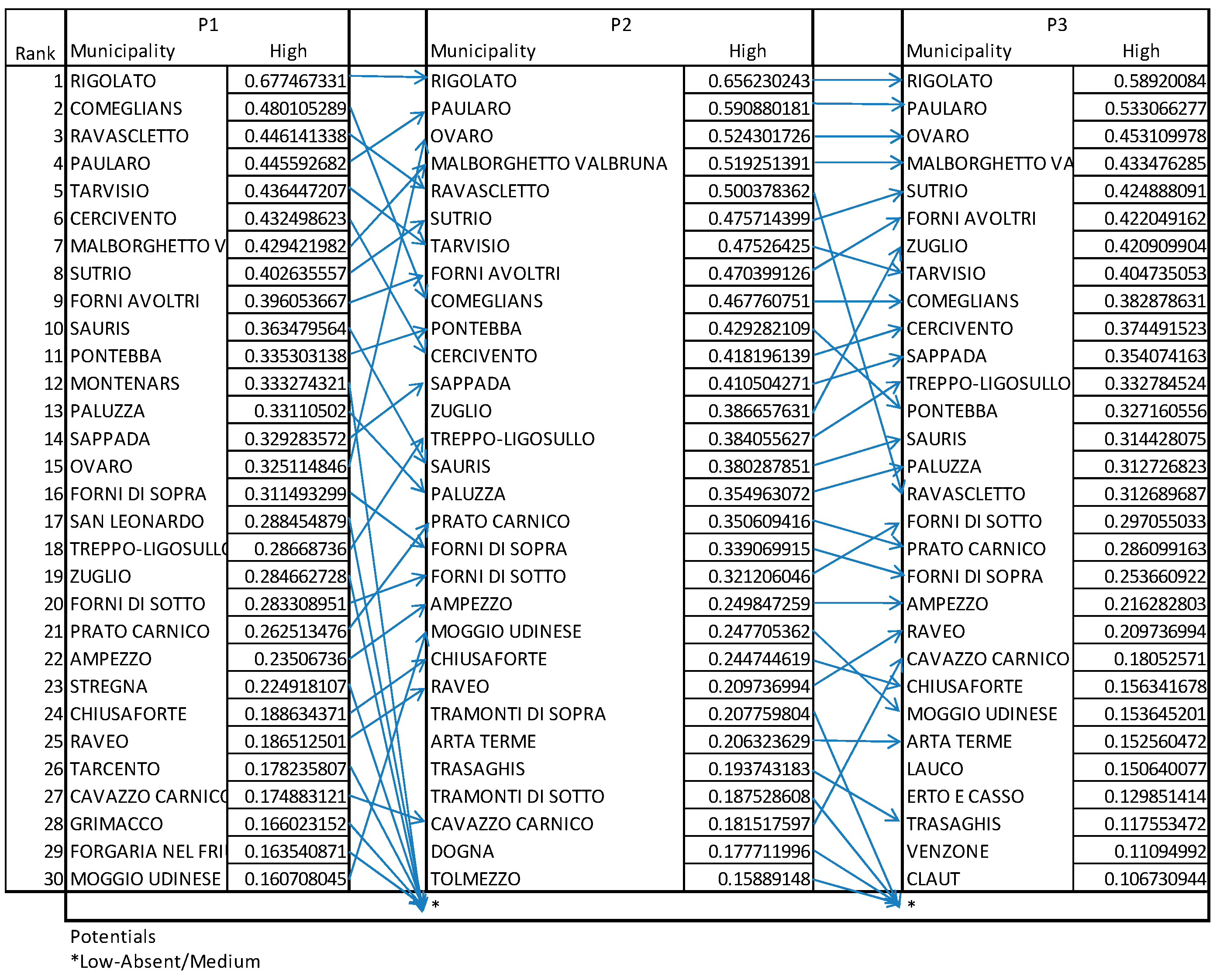
References
- Urban Green Spaces: A Brief for Action. Available online: https://www.euro.who.int/en/health-topics/environment-and-health/urban-health/publications/2017/urban-green-spaces-a-brief-for-action-2017 (accessed on 18 January 2022).
- Van den Bosch, M.; Sang, Å.O. Urban natural environments as nature-based solutions for improved public health—A systematic review of reviews. Environ. Res. 2017, 158, 373–384. [Google Scholar] [CrossRef] [PubMed]
- Wolf, K.L.; Lam, S.T.; McKeen, J.K.; Richardson, G.R.; van den Bosch, M.; Bardekjian, A.C. Urban trees and human health: A scoping review. Int. J. Environ. Res. 2020, 17, 4371. [Google Scholar] [CrossRef] [PubMed]
- Buckley, R.; Westaway, D. Mental health rescue effects of women’s outdoor tourism: A role in COVID-19 recovery. Ann. Tour. Res. 2020, 85, 103041. [Google Scholar] [CrossRef] [PubMed]
- Chen, J.; Vullikanti, A.; Hoops, S.; Mortveit, H.; Lewis, B.; Venkatramanan, S.; You, W.; Eubank, S.; Marathe, M.; Barrett, C.; et al. Medical costs of keeping the US economy open during COVID-19. Sci. Rep. 2020, 10, 18422. [Google Scholar] [CrossRef] [PubMed]
- Thapa, S. A Comprehensive Review on COVID-19 Pandemic: Causes, Effects, and Concerns From Environmental Perspective. J. Environ. Sci. 2021, 17, 196. [Google Scholar]
- Goodell, J.W. COVID-19 and finance: Agendas for future research. Financ. Res. Lett. 2020, 35, 101512. [Google Scholar] [CrossRef]
- Loayza, N. Costs and trade-offs in the fight against the COVID-19 pandemic: A developing country perspective. World Bank Policy Res. 2020, 35, 148535. [Google Scholar]
- Klemeš, J.J.; Van Fan, Y.; Jiang, P. COVID-19 pandemic facilitating energy transition opportunities. Int. J. Energy Res. 2020, 45, 3457–3463. [Google Scholar] [CrossRef]
- Rowan, N.J.; Galanakis, C.M. Unlocking challenges and opportunities presented by COVID-19 pandemic for cross-cutting disruption in agri-food and green deal innovations: Quo Vadis? Sci. Total Environ. 2020, 748, 141362. [Google Scholar] [CrossRef]
- Derks, J.; Giessen, L.; Winkel, G. COVID-19-induced visitor boom reveals the importance of forests as critical infrastructure. For. Policy Econ. 2020, 118, 102253. [Google Scholar] [CrossRef]
- Sustainable Development. Ensure Healthy Lives and Promote Well-Being for All at All Ages. Available online: https://sdgs.un.org/goals/goal3 (accessed on 20 November 2021).
- Constitution of the World Health Organization. Available online: https://apps.who.int/iris/bitstream/handle/10665/121457/em_rc42_cwho_en.pdf (accessed on 20 November 2021).
- Saleh, S.; Shepherd, W.; Jewell, C.; Lam, N.L.; Balmes, J.; Bates, M.N.; Lai, P.S.; Ochieng, C.A.; Chinouya, M.; Mortimer, K.; et al. Air pollution interventions and respiratory health: A systematic review. IJTLD 2020, 24, 150–164. [Google Scholar] [CrossRef] [PubMed] [Green Version]
- Global Forest Resources Assessment 2000, FRA 2000 Main Report. Available online: https://www.fao.org/3/y4171e/Y4171E10.htm (accessed on 27 November 2021).
- COP26, United Nations Climate Change Conference UK 2021. Available online: https://ukcop26.org/glasgow-leaders-declaration-on-forests-and-land-use/ (accessed on 8 November 2021).
- Rajoo, K.S.; Karam, D.S.; Abdullah, M.Z. The Physiological and Psychosocial Effects of Forest Therapy: A Systematic Review. Urban For. Urban Green. 2020, 54, 126744. [Google Scholar] [CrossRef]
- Li, Q. Effect of forest bathing (shinrin-yoku) on human health: A review of the literature. In , (HS1), Special Issue, 2019; pp. 135–143. Santé Publique 2019, S1, 135–143. [Google Scholar] [CrossRef] [PubMed] [Green Version]
- Corazon, S.S.; Sidenius, U.; Poulsen, D.V.; Gramkow, M.C.; Stigsdotter, U.K. Psycho-physiological stress recovery in outdoor nature-based interventions: A systematic review of the past eight years of research. Int. J. Environ. Res. 2019, 16, 1711. [Google Scholar] [CrossRef] [Green Version]
- Twohig-Bennett, C.; Jones, A. The health benefits of the great outdoors: A systematic review and meta-analysis of greenspace exposure and health outcomes. Environ. Res. 2018, 166, 628–637. [Google Scholar] [CrossRef] [PubMed]
- Hansen, M.M.; Jones, R.; Tocchini, K. Shinrin-Yoku (Forest Bathing) and Nature Therapy: A State-of-the-Art Review. Int. J. Environ. Res. Public Health 2017, 14, 851. [Google Scholar] [CrossRef] [Green Version]
- Lee, J.; Park, B.J.; Tsunetsugu, I.; Miyazaki, Y. Forests and Human Health—Recent trends in Japan. In Forest Medicine; Li, Q., Ed.; Nova Science Publishers: New York, NY, USA, 2012; pp. 243–257. [Google Scholar]
- Kamioka, H.; Tsutani, K.; Mutoh, Y.; Honda, T.; Shiozawa, N.; Okada, S.; Park, S.-J.; Kitayuguchi, J.; Kamada, M.; Okuizumi, H.; et al. A systematic review of randomized controlled trials on curative and health enhancement effects of forest therapy. LTWA 2012, 5, 85–95. [Google Scholar] [CrossRef] [Green Version]
- Tsunetsugu, Y.; Park, B.J.; Miyazaki, Y. Trends in research related to “Shinrin-yoku” (taking in the forest atmosphere or forest bathing) in Japan. Environ. Health Prev. Med. 2010, 15, 27–37. [Google Scholar] [CrossRef] [Green Version]
- Park, B.J.; Tsunetsugu, Y.; Kasetani, T.; Kagawa, T.; Miyazaki, Y. The physiological effects of Shinrin-yoku (taking in the forest atmosphere or forest bathing): Evidence from field experiments in 24 forests across Japan. Environ. Health Prev. Med. 2010, 15, 18–26. [Google Scholar] [CrossRef] [Green Version]
- Nature Contributes to Physical and Mental Health. Available online: https://www.fo-society.jp/therapy/cn45/index_en.html (accessed on 2 November 2021).
- Li, Q. Effect of forest bathing trips on human immune function. Environ. Health Prev. Med. 2010, 15, 9–17. [Google Scholar] [CrossRef] [Green Version]
- Brochu, P.; Bouchard, B.; Haddad, S. Physiological daily inhalation rates for health risk assessment in overweight/obese children, adults, and elderly. Risk Anal. 2014, 34, 567–582. [Google Scholar] [CrossRef] [PubMed]
- Buckley, R.; Brough, P.; Hague, L.; Chauvenet, A.; Fleming, C.; Roche, E.; Sofija, E.; Harris, N. Economic value of protected areas via visitor mental health. Nat. Commun. 2019, 10, 5005. [Google Scholar] [CrossRef] [PubMed]
- Gibb, R.; Redding, D.W.; Chin, K.Q.; Donnelly, C.A.; Blackburn, T.M.; Newbold, T.; Jones, K.E. Zoonotic host diversity increases in human-dominated ecosystems. Nature 2020, 584, 398–402. [Google Scholar] [CrossRef]
- Ohe, Y.; Ikei, H.; Song, C.; Miyazaki, Y. Evaluating the relaxation effects of emerging forest-therapy tourism: A multidisciplinary approach. Tour. Manag. 2017, 62, 322–334. [Google Scholar] [CrossRef]
- Coutts, C.; Hahn, M. Green infrastructure, ecosystem services, and human health. Int. J. Environ. Res. 2015, 12, 9768–9798. [Google Scholar] [CrossRef] [PubMed] [Green Version]
- Lindgren, E.; Elmqvist, T. Ecosystem services and human health. In Oxford Research Encyclopedia, Environmental Science; Oxford University Press: Oxford, UK, 2017. [Google Scholar]
- Braat, L.C.; De Groot, R. The ecosystem services agenda: Bridging the worlds of natural science and economics, conservation and development, and public and private policy. Ecosyst. Serv. 2012, 1, 4–15. [Google Scholar] [CrossRef] [Green Version]
- Lee, I.; Choi, H.; Bang, K.S.; Kim, S.; Song, M.; Lee, B. Effects of forest therapy on depressive symptoms among adults: A systematic review. Int. J. Environ. 2017, 14, 321. [Google Scholar] [CrossRef]
- Meneguzzo, F.; Zabini, F. Forest Ecosystem Services for Human Health. In Agri-Food and Forestry Sectors for Sustainable Development; Springer: Berlin/Heidelberg, Germany, 2021; pp. 33–53. [Google Scholar]
- Schirpke, U.; Scolozzi, R.; De Marco, C.; Tappeiner, U. Mapping beneficiaries of ecosystem services flows from Natura 2000 sites. Ecosyst. Serv. 2014, 9, 170–179. [Google Scholar] [CrossRef]
- Droli, M.; Radivo, G.G.; Iseppi, L. Does the Establishment of a ‘Forest Therapy Station’ in a Low-Mountain Mixed Hardwood Forest Make Sense? In International Symposium: New Metropolitan Perspectives; Springer: Cham, Switzerland, 2020; pp. 67–79. [Google Scholar]
- Cho, K.S.; Lim, Y.R.; Lee, K.; Lee, J.; Lee, J.H.; Lee, I.S. Terpenes from forests and human health. Toxicol. Res. 2017, 33, 97–106. [Google Scholar] [CrossRef]
- Šimpraga, M.; Ghimire, R.P.; Van Der Straeten, D.; Blande, J.D.; Kasurinen, A.; Sorvari, J.; Holopainen, T.; Adriaenssens, S.; Holopainen, J.K.; Kivimäenpää, M. Unravelling the functions of biogenic volatiles in boreal and temperate forest ecosystems. Eur. J. For. Res. 2019, 138, 763–787. [Google Scholar] [CrossRef] [Green Version]
- Adebesin, F.; Widhalm, J.R.; Boachon, B.; Lefevre, F.; Pierman, B.; Lynch, J.H.; Alam, I.; Junqueira, B.; Benke, R.; Ray, S.; et al. Emission of volatile organic compounds from petunia flowers is facilitated by an ABC transporter. Science 2017, 356, 1386–1388. [Google Scholar] [CrossRef] [PubMed] [Green Version]
- Bach, A.; Yáñez-Serrano, A.M.; Llusià, J.; Filella, I.; Maneja, R.; Penuelas, J. Human breathable air in a Mediterranean forest: Characterization of monoterpene concentrations under the canopy. Int. J. Environ. Res. Public Health 2020, 17, 4391. [Google Scholar] [CrossRef] [PubMed]
- The Economic Consequences of Outdoor Air Pollution. Available online: https://www.oecd.org/environment/indicators-modelling-outlooks/Policy-Highlights-Economic-consequences-of-outdoor-air-pollution-web.pdf (accessed on 18 January 2022).
- Peteraf, M.A. The cornerstones of competitive advantage: A resource-based view. Strat. Manag. J. 1993, 14, 179–191. [Google Scholar] [CrossRef]
- Foreste Per Il Clima. Available online: https://www.crea.gov.it/documents/20126/0/CREA_+CS_+INVENTARIO+FORESTALE+e+serbatori+di+carbonio+con+Arma+Carabinieri.pdf/f5b66457-47f6-5d61-6d75-0b23cd23be39?t=1632904349072 (accessed on 3 November 2021).
- I Numeri Delle Foreste in FVG. Available online: https://www.regione.fvg.it/rafvg/export/sites/default/RAFVG/economia-imprese/allegati/DatiIFNC2007_11_19.pdf (accessed on 3 November 2021).
- SITFOR, FVG. Available online: https://www.regione.fvg.it/rafvg/export/sites/default/RAFVG/economia-imprese/agricoltura-foreste/foreste/FOGLIA202/allegati/Tipi_forestaliMAG2014.jpg (accessed on 22 October 2021).
- La Vegetazione Forestale la Selvicoltura Nella Regione Friuli Venezia Giulia. Available online: https://www.regione.fvg.it/rafvg/export/sites/default/RAFVG/economia-imprese/agricoltura-foreste/foreste/allegati/Del_Favero_-_La_vegetazione_forestale_e_la_selvicoltura_in_FVG.pdf (accessed on 18 January 2022).
- Salvagni, E.; Moimas, F.; Marchiol, A.; Baiutti, E.; Marotta, A.; Canciani, M. Importance of Indoor Air Pollution in a Paediatric Population. Available online: https://www.ers-education.org/lr/show-details/?idP=49225 (accessed on 18 January 2022).
- Saretta, F.; Guerra, T.; Cossettini, M.; Cuomo, B.; Morittu, A.; Canciani, M. Nitric Oxide and Holiday Camps on High Altitude. Available online: https://www.ers-education.org/lr/show-details/?idP=14575 (accessed on 18 January 2022).
- Saretta, F.; Pizzimenti, C.; Poser, S.; Toller, I.; Guerra, M.; Zanor, S.; Canciani, M. Variation of Oxygen Uptake in Asthmatic Children during Summer Holiday Camp in High Mountain. Available online: https://www.ers-education.org/lr/show-details/?idP=56329 (accessed on 18 January 2022).
- De Pieri, C.; Arigliani, M.; Francescato, M.P.; Vidoni, M.; Ferrari, M.E.; Cogo, P.; Canciani, M.C. The effect of asthma on cardiorespiratory endurance (CRE) in children. Eur. Clin. Respir. J. 2017, 50, 591. [Google Scholar]
- Droli, M.; Nardini, S.; Canciani, M.C. The psychological benefits of forest bathing in a mixed low-altitude mountain forest in the Eastern Alps in Italy: An ecosystem services approach. In Proceedings of the 2nd International Conference on Food and Agricultural Economics—ICFAEC, Alanya, Turkey, 28–29 April 2018. [Google Scholar]
- De Pieri, C.; Arigliani, M.; Francescato, M.P.; Droli, M.; Vidoni, M.; Liguoro, I.; Ferrari, M.E.; Cogo, P.; Canciani, M.C. The Effects of Climate Therapy on Cardiorespiratory Fitness and Exercise-Induced Bronchoconstriction in Children with Asthma. Atmosphere 2021, 12, 1486. [Google Scholar] [CrossRef]
- Stazione di Terapia Forestale Friuli Venezia Giulia. Available online: https://www.stazioneterapiaforestale.it/ (accessed on 18 January 2022).
- Rapporto Sullo Stato Delle Foreste e del Settore Forestale in Italia. Available online: https://www.reterurale.it/flex/cm/pages/ServeAttachment.php/L/IT/D/8%252F4%252F1%252FD.f8bffe877b6ff2584b21/P/BLOB%3AID%3D19231/E/pdf (accessed on 18 January 2022).
- Case Studies Factsheets. Available online: https://www.greenforcare.eu/case-studies/ (accessed on 18 January 2022).
- Air Quality Life Index. Document. Available online: https://aqli.epic.uchicago.edu/wp-content/uploads/2021/08/AQLI_2021-Report.EnglishGlobal.pdf (accessed on 18 January 2022).
- Barney, J.B.; Ketchen, D.J.; Wright, M. The future of resource-based theory: Revitalization or decline? J. Manag. Stud. 2011, 37, 1299–1315. [Google Scholar] [CrossRef]
- Barney, J. Firm resources and sustained competitive advantage. J. Manag. 1991, 17, 99–120. [Google Scholar] [CrossRef]
- Wernerfelt, B. A resource-based view of the firm. Strateg. Manag. J. 1984, 5, 171–180. [Google Scholar] [CrossRef]
- Penrose, E.; Penrose, E.T. The Theory of the Growth of the Firm; Oxford University Press: Oxford, UK, 2009. [Google Scholar]
- Foss, N.J.; Husted, K.; Michailova, S. Governing knowledge sharing in organizations: Levels of analysis, governance mechanisms, and research directions. J. Manag. Stud. 2010, 47, 455–482. [Google Scholar] [CrossRef]
- Grant, R.M. Toward a knowledge-based theory of the firm. Strateg. Manag. J. 1996, 17, 109–122. [Google Scholar] [CrossRef]
- Godfrey, P.C.; Hill, C.W.L. The problem of unobservables in strategic management research. Strateg. Manag. J. 1995, 16, 519–533. [Google Scholar] [CrossRef]
- Hart, S.L. A natural-resource-based view of the firm. Acad. Manag. Rev. 1995, 20, 986–1014. [Google Scholar] [CrossRef] [Green Version]
- Seppelt, R.; Dormann, C.F.; Eppink, F.V.; Lautenbach, S.; Schmidt, S. A quantitative review of ecosystem service studies: Approaches, shortcomings and theory ahead. J. Appl. Ecol. 2011, 48, 630–636. [Google Scholar] [CrossRef]
- Confini Delle Unità Amministrative a Fini Statistici al 1° Gennaio 2021. Available online: https://www.istat.it/it/archivio/222527 (accessed on 18 January 2022).
- Infrastruttura Regionale dei Dati Ambientali e Territoriali—IRDAT. Available online: https://www.regione.fvg.it/rafvg/cms/RAFVG/ambiente-territorio/conoscere-ambiente-territorio/FOGLIA2/ (accessed on 18 January 2022).
- Foreste. Dati Forestali. Dati Regionali Regione Autonoma Friuli Venezia Giulia. Available online: https://www.regione.fvg.it/rafvg/cms/RAFVG/economia-imprese/agricoltura-foreste/foreste/FOGLIA202/ (accessed on 18 January 2022).
- Truesdell, L.E. The Development of Punch Card Tabulation in the Bureau of the Census, 1890–1940: With Outlines of Actual Tabulation Programs; National Government Publication; U.S. Government Printing Office: Washingthon, DC, USA, 1965.
- Brillouin, L. Science and Information Theory; Courier Corporation: Chelmsford, MA, USA, 2013. [Google Scholar]
- Dörner, D. On the difficulties people have in dealing with complexity. Simul. Gaming 1980, 11, 106–187. [Google Scholar] [CrossRef]
- Hodgins, H.J. Mechanical tabulation of forest data. For. Chron. 1940, 16, 85–93. [Google Scholar] [CrossRef]
- Sollins, I.V. The Hollerith statistical technique. Sociol. Educ. 1932, 6, 43–51. [Google Scholar] [CrossRef]
- Seo, S.C.; Park, S.J.; Park, C.W.; Yoon, W.S.; Choung, J.T.; Yoo, Y. Clinical and immunological effects of a forest trip in children with asthma and atopic dermatitis. IJAAI 2015, 14, 28–36. [Google Scholar]
- Schumpeter, J.A. Vilfredo Pareto (1848–1923). Q. J. Econ. 1949, 63, 147–173. [Google Scholar] [CrossRef]
- Reinert, H.; Reinert, E.S. Creative destruction in economics: Nietzsche, Sombart, schumpeter. In Friedrich Nietzsche (1844–1900); Springer: Boston, MA, USA, 2006; pp. 55–85. [Google Scholar]
- Smelser, N.J. Theory of Collective Behavior; Free Press: New York, NY, USA, 1962. [Google Scholar]
- Andersen, L.; Corazon, S.S.S.; Stigsdotter, U.K.K. Nature Exposure and Its Effects on Immune System Functioning: A Systematic Review. Int. J. Environ. Res. 2021, 18, 1416. [Google Scholar] [CrossRef]
- Geron, C.; Rasmussen, R.; Arnts, R.R.; Guenther, A. A review and synthesis of monoterpene speciation from forests in the United States. Atmos. Environ. 2000, 34, 1761–1781. [Google Scholar] [CrossRef] [Green Version]
- Räisänen, T.R.A.; Kellomäki, S. Impact of timber felling on the ambient monoterpene concentration of a Scots pine (Pinus sylvestris L.). For. Atmos. Environ. 2008, 42, 6759–6766. [Google Scholar] [CrossRef]
- Turtola, S.; Manninen, A.M.; Holopainen, J.K.; Levula, T.; Raitio, H.; Kainulainen, P. Secondary metabolite concentrations and terpene emissions of Scots pine xylem after long-term forest fertilization. J. Environ. Qual. 2002, 31, 1694–1701. [Google Scholar] [CrossRef]
- Kainulainen, P.; Holopainen, T.; Holopainen, J. Decomposition of secondary compounds from needle litter of Scots pine grown under elevated CO2 and O3. Glob. Chang. Biol. 2003, 9, 295–304. [Google Scholar] [CrossRef]
- Oosterbroek, B.; Kraker, J.; Huynen, M.M.T.; Martens, P. Assessing ecosystem impacts on health: A tool review. Ecosyst. Serv. 2016, 17, 237–254. [Google Scholar] [CrossRef]
- Allergen Nomenclature. Available online: http://www.allergen.org/viewallergen.php?aid=19 (accessed on 18 January 2022).
- Wagner, K.H.; Elmadfa, I. Biological relevance of terpenoids. Ann. Nutr. Metab. 2003, 47, 95–106. [Google Scholar] [CrossRef] [PubMed]
- Karl, M.; Guenther, A.; Koble, R.; Leip, A.; Seufert, G. A new European plant-specific emission inventory of biogenic volatile organic compounds for use in atmospheric transport models. Biogeosciences 2009, 6, 1059–1087. [Google Scholar] [CrossRef]
- Sharkey, T.D. Isoprene synthesis by plants and animals. Endeavour 1996, 20, 74–78. [Google Scholar] [CrossRef]
- Paulot, F.; Crounse, J.D.; Kjaergaard, H.G.; Kürten, A.; Clair, J.M.S.; Seinfeld, J.H.; Wennberg, P.O. Unexpected epoxide formation in the gas-phase photooxidation of isoprene. Science 2009, 325, 730–733. [Google Scholar] [CrossRef] [Green Version]
- Wojtunik-Kulesza, K.A.; Targowska-Duda, K.; Klimek, K.; Ginalska, G.; Jóźwiak, K.; Waksmundzka-Hajnos, M.; Cieśla, Ł. Volatile terpenoids as potential drug leads in Alzheimer’s disease. Open Chem. J. 2017, 15, 332–343. [Google Scholar] [CrossRef] [Green Version]
- Wang, G.; Tang, W.; Bidigare, R.R. Terpenoids as therapeutic drugs and pharmaceutical agents. In Natural Products; Humana Press: Totowa, NJ, USA, 2005; pp. 197–227. [Google Scholar]
- Kopaczyk, J.M.; Warguła, J.; Jelonek, T. The variability of terpenes in conifers under developmental and environmental stimuli. Environ. Exp. Bot. 2020, 180, 104197. [Google Scholar] [CrossRef]
- Antonelli, M.; Donelli, D.; Barbieri, G.; Valussi, M.; Maggini, V.; Firenzuoli, F. Forest volatile organic compounds and their effects on human health: A state-of-the-art review. Int. J. Environ. Res. Public Health 2020, 17, 6506. [Google Scholar] [CrossRef] [PubMed]
- Filippini, T.; Rothman, K.J.; Cocchio, S.; Narne, E.; Mantoan, D.; Saia, M.; Goffi, A.; Ferrari, F.; Maffeis, G.; Orsini, N.; et al. Associations between mortality from COVID-19 in two Italian regions and outdoor air pollution as assessed through tropospheric nitrogen dioxide. Sci. Total Environ. 2021, 760, 143355. [Google Scholar] [CrossRef] [PubMed]
- Zorić, M.; Kostić, S.; Kladar, N.; Božin, B.; Vasić, V.; Kebert, M.; Orlović, S. Phytochemical Screening of Volatile Organic Compounds in Three Common Coniferous Tree Species in Terms of Forest Ecosystem Services. Forests 2021, 12, 928. [Google Scholar] [CrossRef]
- Meneguzzo, F.; Albanese, L.; Bartolini, G.; Zabini, F. Temporal and spatial variability of volatile organic compounds in the forest atmosphere. Int. J. Environ. Res. Public Health 2019, 16, 4915. [Google Scholar] [CrossRef] [PubMed] [Green Version]
- Campanelli, M.; Iannarelli, A.M.; Mevi, G.; Casadio, S.; Diémoz, H.; Finardi, S.; Dinoi, A.; Castelli, E.; Di Sarra, A.; Di Bernardino, A.; et al. A wide-ranging investigation of the COVID-19 lockdown effects on the atmospheric composition in various Italian urban sites (AER–LOCUS). Urban Clim. 2021, 39, 100954. [Google Scholar] [CrossRef]
- Funke, J. Solving complex problems: Exploration and control of complex systems. In Complex Problem Solving: Principles and Mechanisms; Lawrence Erlbaum: Hillsdale, NJ, USA, 1991; Volume 4, pp. 185–222. [Google Scholar]
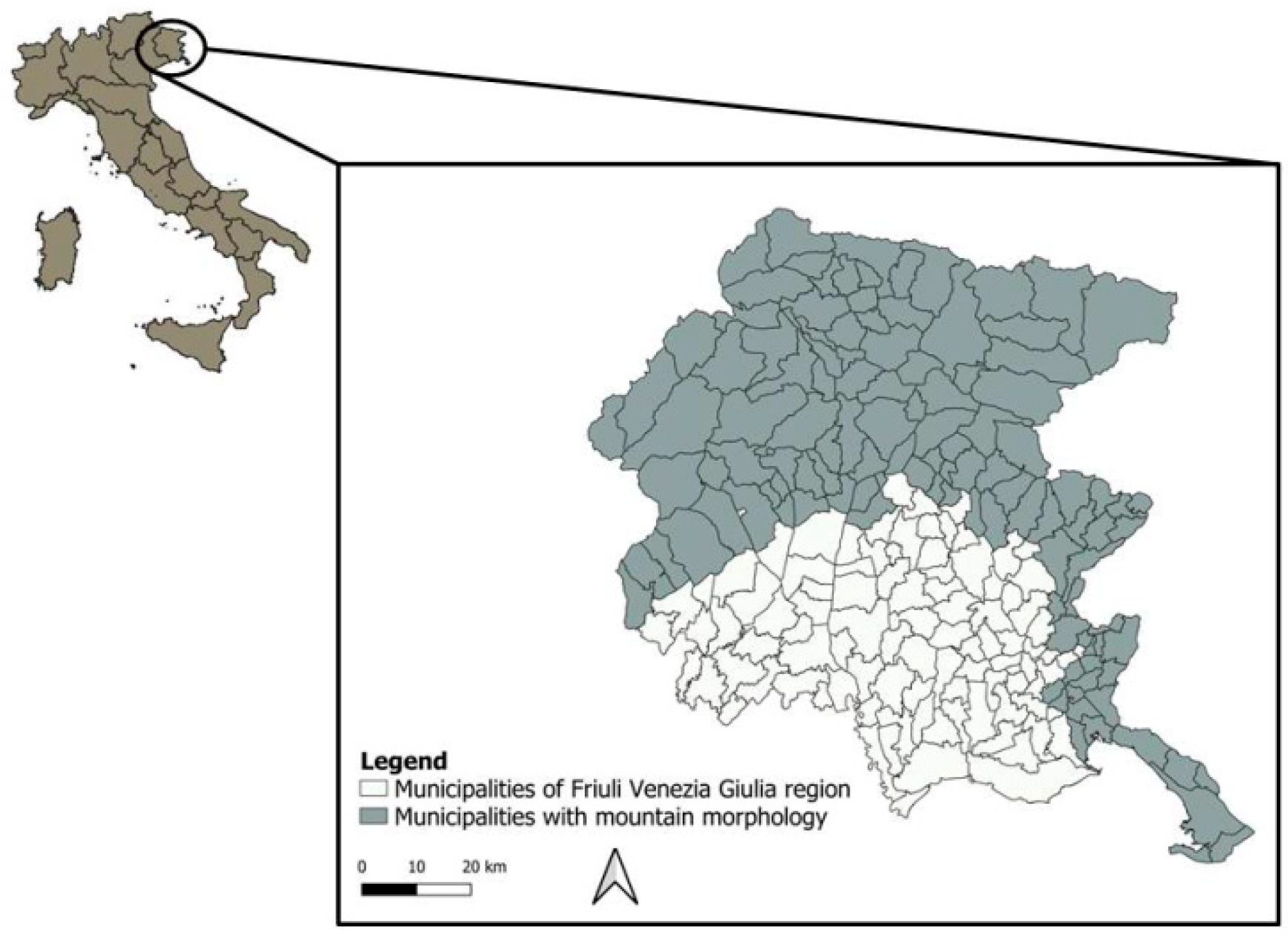
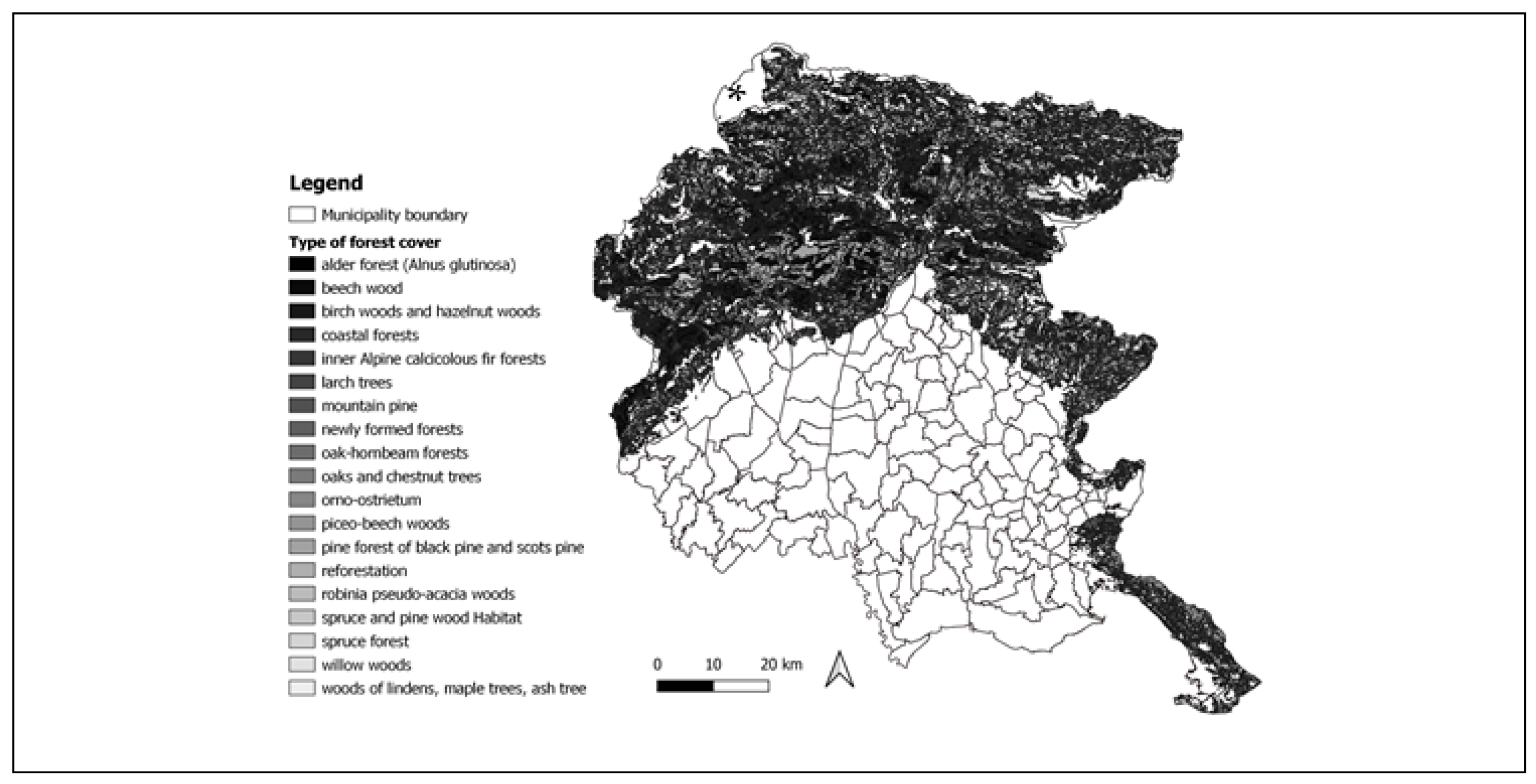
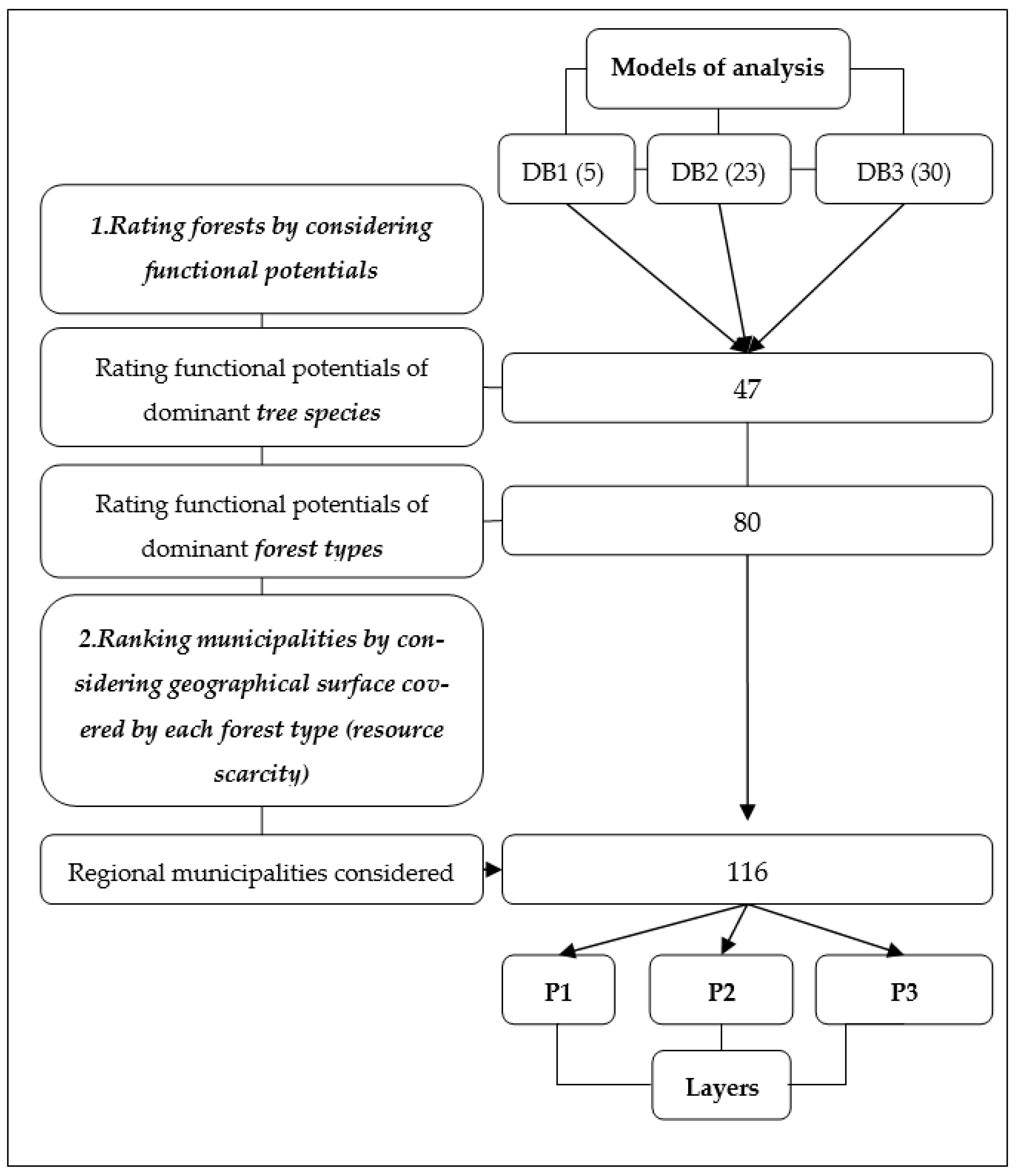
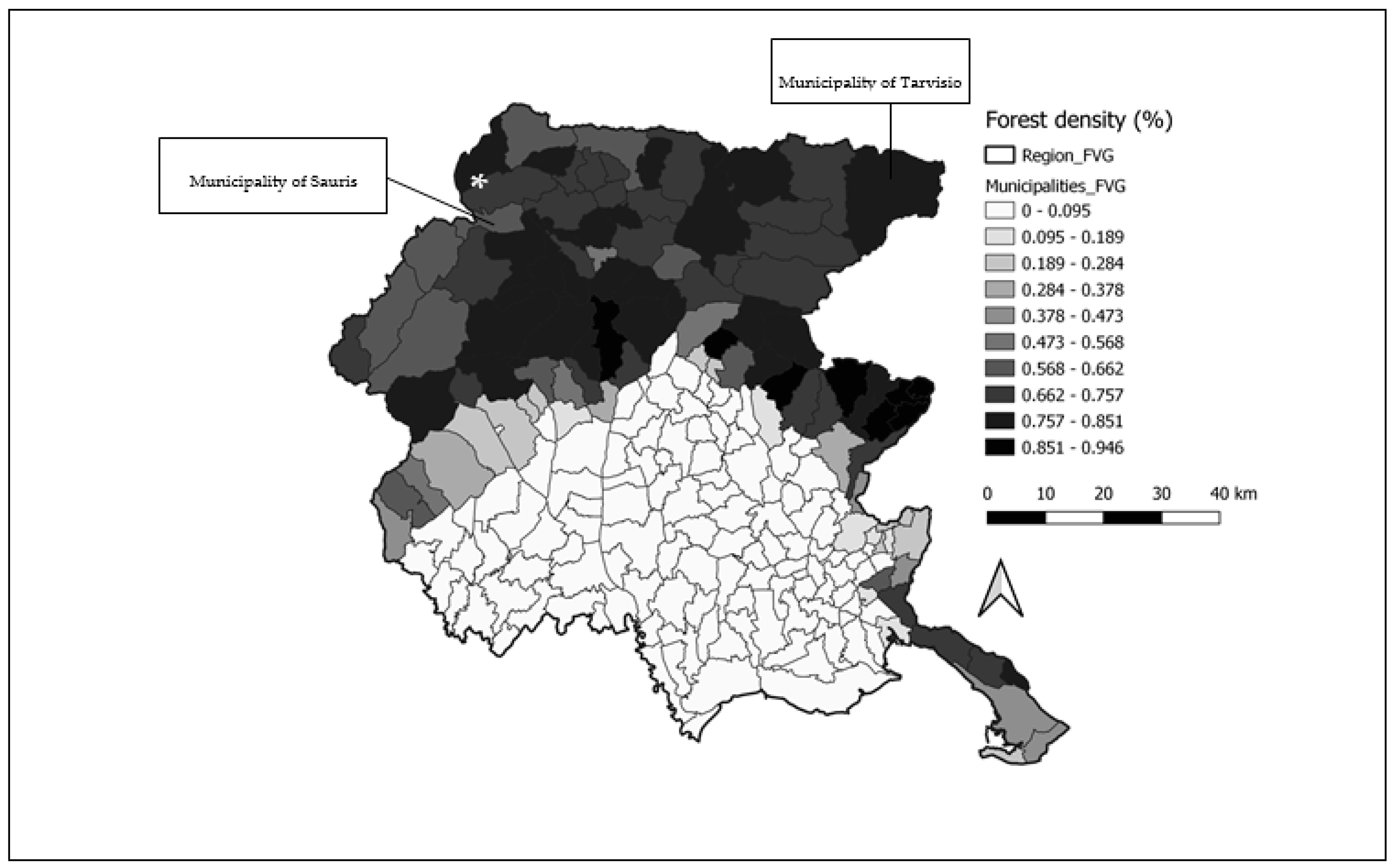
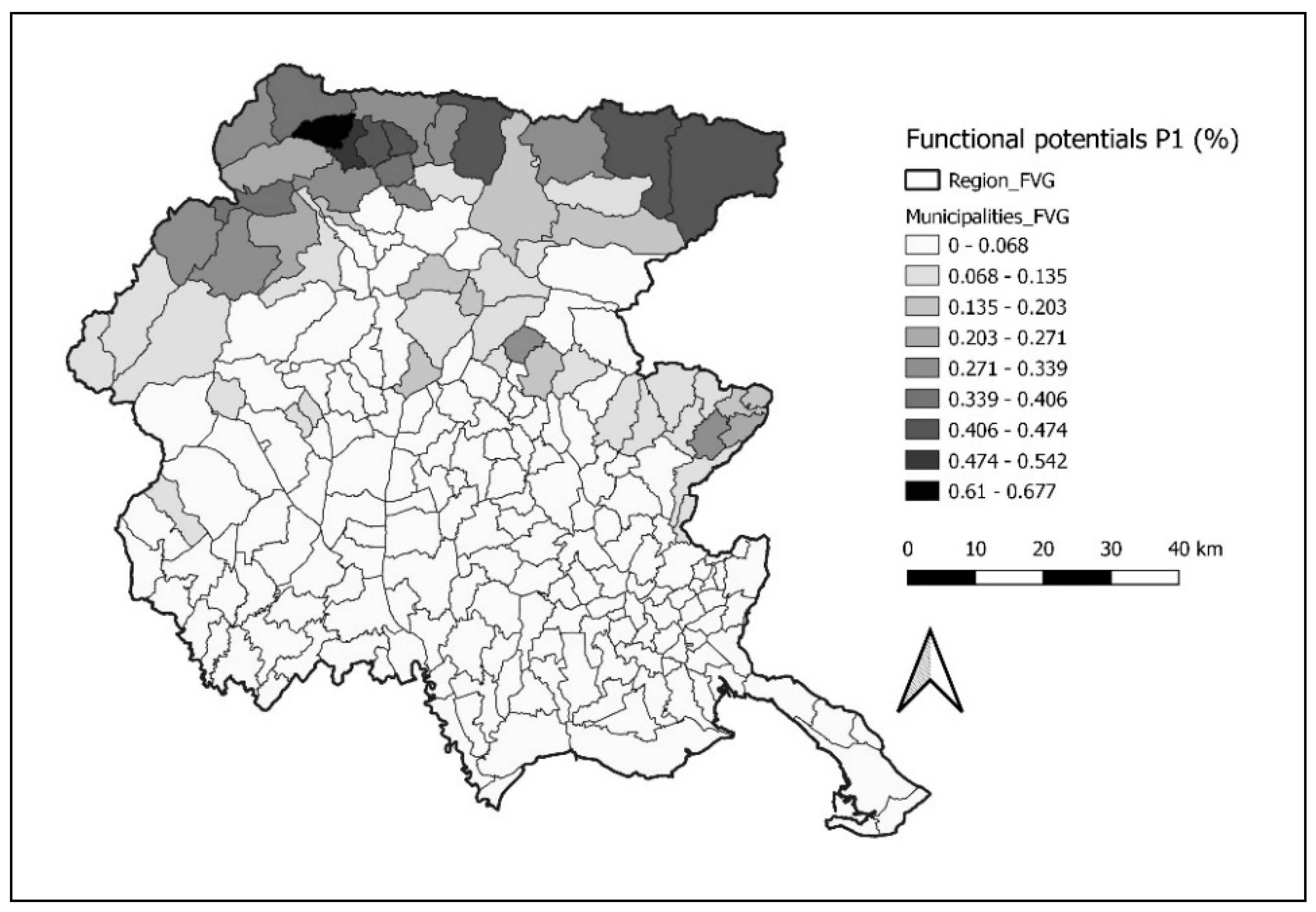
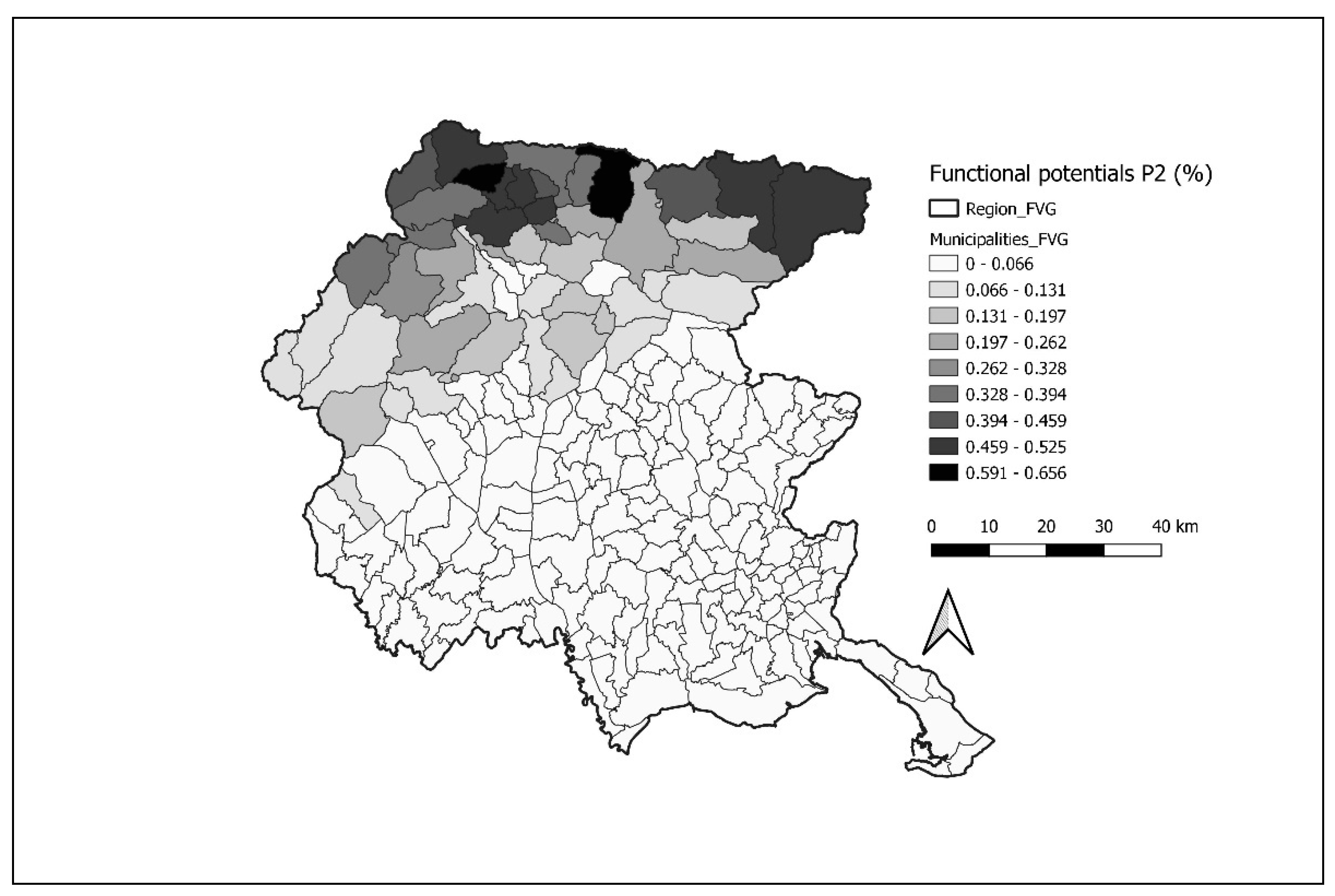
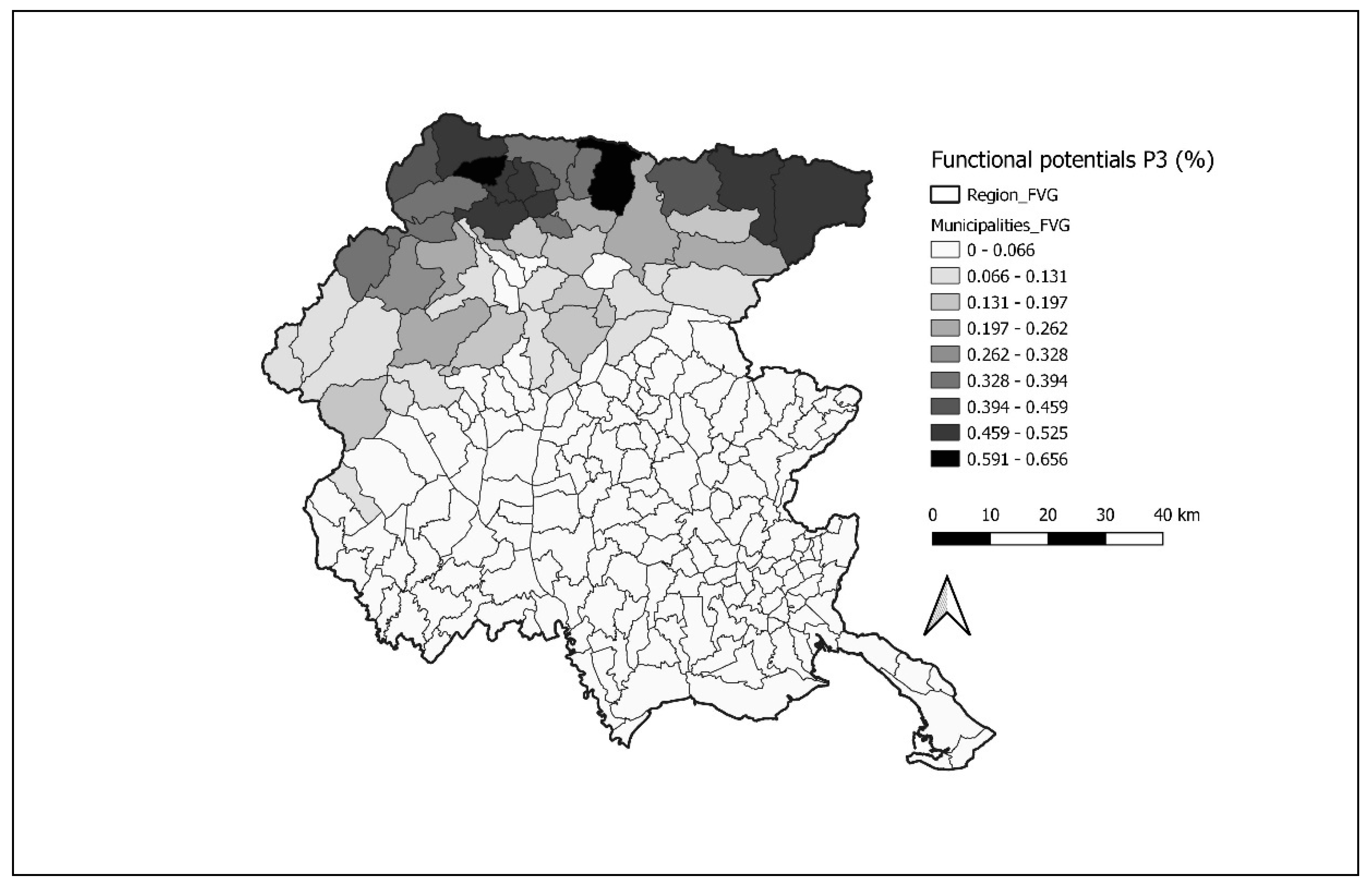

| N. | Key-Performances | Sources |
|---|---|---|
| 1 | No/extremely low potentially negative effects of the inhalation of pollens | [86] |
| 2 | No/extremely low potentially negative effects of inhalation of isoprene emissions | [40] (Table 2 p. 768); [88,89,90] |
| 3 | Monoterpenes (C atoms:10) | [40] (Table 2 p. 768); [81,88] |
| 4 | Sesquiterpenes (C atoms:15) | [40] (Table 2 p. 768); [81,88] |
| 5 | Stored MTS | [40] (Table 2 p. 768); [81,88] |
| N. | Functional Aerosols | N. | Functional Aerosols | N. | Functional Aerosols |
|---|---|---|---|---|---|
| 1 | borneol (b) (M) | 9 | 3-carene (a) (M) | 17 | β-phellandrene (a, d) (M) |
| 2 | bornyl acetate (a, b) (M) | 10 | perrillyl alchol (b) (M) | 18 | β-pinene (a, d) (M) |
| 3 | camphene (a, d) (M) | 11 | pinene (b) (M) | 19 | d-Limonene (d) (M) |
| 4 | carvone (c) (M) | 12 | pulegone (c) (M) | 20 | γ-terpinene (a, c) (M) |
| 5 | cymene (b, d) (M) | 13 | sabinene (a, b) (M) | 21 | caryophyllene (b) (S) |
| 6 | limonene (a, b) (M) | 14 | terpinene (b) (M) | 22 | 1,8-Cyneole (b, d) (S) |
| 7 | linalool (b) (M) | 15 | α-pinene (a, d) (M) | 23 | 1-Octanol (b) (S) |
| 8 | myrcene (a, b, d) (M) | 16 | β-myrcene (a) (M) |
| N | BVOC | Antiox. | Anti-Infl. | Neuroprot. | Immunostim. |
|---|---|---|---|---|---|
| 1 | Borneol | X (a) | X (a) | X (a) | |
| 2 | Bornyl acetate | X (a) | |||
| 3 | Camphene | ||||
| 4 | Carvone | X (b) | X (c) | ||
| 5 | Cymene | X (a) | X (a) | X (a) | |
| 6 | Limonene | X (a) | X (a) | X (a,c) | |
| 7 | Linalool | X (a) | |||
| 8 | Myrcene | X (a) | X (a) | ||
| 9 | 3-carene | ||||
| 10 | Perrillyl alchol | X (a,c) | |||
| 11 | Pinene | X (a) | X (a) | X (a) | X (a) |
| 12 | Pulegone | X (b) | |||
| 13 | Sabinene | X (a) | |||
| 14 | Terpinene | X (a) | |||
| 15 | α-pinene | ||||
| 16 | β-myrcene | ||||
| 17 | β-phellandrene | ||||
| 18 | β-pinene | ||||
| 19 | d-Limonene | ||||
| 20 | γ-terpinene | X (b) | |||
| 21 | Caryophyllene | X (a) | X (a) | X (a) | |
| 22 | 1,8-Cyneole | X (a) | X (a) | ||
| 23 | 1-Octanol | X (a) | |||
| TOT BVOCs functions | 5 | 11 | 8 | 6 |
| Potential Respiratory Benefits | Municipalities |
|---|---|
| (a) High (rank: 1–29), Ist quartile | RIGOLATO (0.678), COMEGLIANS (0.48), RAVASCLETTO (0.446), PAULARO (0.446), TARVISIO (0.436), CERCIVENTO (0.432), MALBORGHETTO VALBRUNA (0.429), SUTRIO (0.403), FORNI AVOLTRI (0.396), SAURIS (0.363), PONTEBBA (0.335), MONTENARS (0.333), PALUZZA (0.331), SAPPADA (0.329), OVARO (0.325), FORNI DI SOPRA (0.311), SAN LEONARDO (0.288), TREPPO-LIGOSULLO (0.287), ZUGLIO (0.285), FORNI DI SOTTO (0.283), PRATO CARNICO (0.263), AMPEZZO (0.235), STREGNA (0.225), CHIUSAFORTE (0.189), RAVEO (0.186), TARCENTO (0.178), CAVAZZO CARNICO (0.175), GRIMACCO (0.166), e FORGARIA NEL FRIULI (0.163). |
| (b) Medium (rank: 30–58), IInd quartile | MOGGIO UDINESE (0.161), DRENCHIA (0.157), BORDANO (0.137), ARTEGNA (0.135), TORREANO (0.133), ERTO E CASSO (0.13), TRASAGHIS(0.122), CLAUT (0.115), PULFERO (0.111), DOGNA (0.105), VENZONE (0.105), BUDOIA (0.098), ANDREIS (0.098), FANNA (0.092), CAVASSO NUOVO (0.092), GEMONA DEL FRIULI (0.091), CIMOLAIS (0.09), PREPOTTO (0.086), SAVOGNA (0.084), ARTA TERME (0.083), RESIUTTA (0.083), SOCCHIEVE (0.081), DOLEGNA DEL COLLIO (0.078), SAN PIETRO AL NATISONE (0.072),FAEDIS (0.071), NIMIS (0.071), VERZEGNIS (0.067), BARCIS (0.066), POLCENIGO (0.062). |
| (c) Low/No potentials (rank: 59–87); IIIrd quartile | TRAMONTI DI SOPRA (0.06), RESIA (0.054), SEQUALS (0.043), ATTIMIS (0.041), TOLMEZZO (0.041), FRISANCO (0.039), CIVIDALE DEL FRIULI (0.039), VITO D’ASIO (0.039), AVIANO (0.037), CORMONS (0.034), LUSEVERA (0.032), PINZANO AL TAGLIAMENTO (0.031), MAGNANO IN RIVIERA (0.031), PREONE (0.03), MONTEREALE VALCELLINA (0.029), LAUCO (0.026), TRAMONTI DI SOTTO (0.026), POVOLETTO (0.024), SAN FLORIANO DEL COLLIO (0.024), CASTELNOVO DEL FRIULI (0.021), CLAUZETTO (0.021), MANIAGO (0.018), TRAVESIO (0.015), ENEMONZO (0.01), CAPRIVA DEL FRIULI (0.009), GORIZIA (0.008), CANEVA (0.006), VILLA SANTINA (0.005), e SAN LORENZO ISONTINO (0.004). |
| Potential Respiratory Benefits | Municipalities |
|---|---|
| (a) High (rank: 1–29), Ist quartile | RIGOLATO (0.656), PAULARO (0.591), OVARO (0.524), MALBORGHETTO VALBRUNA (0.519), RAVASCLETTO (0.501), SUTRIO (0.476), TARVISIO (0.475), FORNI AVOLTRI (0.47), COMEGLIANS (0.468), PONTEBBA (0.429), CERCIVENTO (0.418), SAPPADA (0.41), ZUGLIO (0.387), TREPPO-LIGOSULLO (0.384), SAURIS (0.381), PALUZZA (0.355), PRATO CARNICO (0.351), FORNI DI SOPRA (0.339), FORNI DI SOTTO (0.321), AMPEZZO (0.25), MOGGIO UDINESE (0.248), CHIUSAFORTE (0.245), RAVEO (0.21), TRAMONTI DI SOPRA (0.208), ARTA TERME (0.206), TRASAGHIS (0.194), TRAMONTI DI SOTTO (0.187), CAVAZZO CARNICO (0.181), e DOGNA (0.178). |
| (b) Medium (rank: 30–58), IInd quartile | TOLMEZZO (0.159), BARCIS (0.155), LAUCO (0.151), BORDANO (0.137), ERTO E CASSO (0.13), RESIUTTA (0.125), CLAUT (0.121), VENZONE (0.112), VITO D’ASIO (0.112), CIMOLAIS (0.102), RESIA (0.102), SOCCHIEVE (0.099), ANDREIS (0.098), BUDOIA (0.095), FRISANCO (0.093), GEMONA DEL FRIULI (0.092), FORGARIA NEL FRIULI (0.088), VERZEGNIS (0.082), POLCENIGO (0.061), ENEMONZO (0.043), AVIANO (0.037), PREONE (0.033), MONTEREALE VALCELLINA (0.029), AMARO (0.026), VILLA SANTINA (0.025), CLAUZETTO (0.02), MONTENARS (0.011), ARTEGNA (0.009), e CANEVA (0.006). |
| (c) Low/No potentials (rank: 59–87); IIIrd quartile | LUSEVERA (0.001), other municipalities = 0. |
| Potential Respiratory Benefits | Municipalities |
|---|---|
| (a) High (rank: 1–29), Ist quartile | RIGOLATO (0.589), PAULARO (0.533), OVARO (0.453), MALBORGHETTO VALBRUNA (0.433), SUTRIO (0.425), FORNI AVOLTRI (0.422), ZUGLIO (0.421), TARVISIO (0.405), COMEGLIANS (0.383), CERCIVENTO (0.375), SAPPADA (0.354), TREPPO-LIGOSULLO (0.333), PONTEBBA (0.327), SAURIS (0.314), PALUZZA (0.313), RAVASCLETTO (0.313), FORNI DI SOTTO (0.297), PRATO CARNICO (0.286), FORNI DI SOPRA (0.254), AMPEZZO (0.216), RAVEO (0.21), CAVAZZO CARNICO (0.18), CHIUSAFORTE (0.156), MOGGIO UDINESE (0.154), ARTA TERME (0.152), LAUCO (0.151), ERTO E CASSO (0.13), TRASAGHIS (0.117), e VENZONE (0.111). |
| (b) Medium (rank: 30–58), IInd quartile | CLAUT (0.107), BORDANO (0.098), ANDREIS (0.098), DOGNA (0.095), SOCCHIEVE (0.091), FORGARIA NEL FRIULI (0.088), BUDOIA (0.08), VERZEGNIS (0.079), BARCIS (0.077), GEMONA DEL FRIULI (0.076), RESIUTTA (0.07), CIMOLAIS (0.065), TOLMEZZO (0.065), RESIA (0.061), TRAMONTI DI SOPRA (0.047), AVIANO (0.04), PREONE (0.03), MONTEREALE VALCELLINA (0.029), FRISANCO (0.029), TRAMONTI DI SOTTO (0.026), POLCENIGO (0.014), ENEMONZO (0.01), MONTENARS (0.009), VILLA SANTINA (0.009), ARTEGNA (0.002), LUSEVERA (0.001), VITO D’ASIO, and MAGNANO IN RIVIERA. |
| (c) Low/No potentials (rank: 59–87); IIIrd quartile | No municipalities are ranked as low/no potentials. |
| Potential Respiratory Benefits | Municipalities |
|---|---|
| (a) High (rank: 1–29), Ist quartile | RIGOLATO (0.61), COMEGLIANS (0.518), CERCIVENTO (0.503), PAULARO (0.479), MALBORGHETTO VALBRUNA (0.479), FORNI AVOLTRI (0.449), TARVISIO (0.425), SAPPADA (0.396), SUTRIO (0.392), PONTEBBA (0.377), OVARO (0.37), SAURIS (0.352), PRATO CARNICO (0.343), FORNI DI SOPRA (0.339), PALUZZA (0.337), TREPPO-LIGOSULLO (0.29), FORNI DI SOTTO (0.285), RAVASCLETTO (0.283), ZUGLIO (0.263), AMPEZZO (0.225652309), CHIUSAFORTE (0.187), RAVEO (0.186), CAVAZZO CARNICO (0.18), MOGGIO UDINESE (0.154), DRENCHIA (0.147), BORDANO (0.137), ERTO E CASSO (0.13), BARCIS (0.122), FORGARIA NEL FRIULI (0.12), and CLAUT (0.11). |
Publisher’s Note: MDPI stays neutral with regard to jurisdictional claims in published maps and institutional affiliations. |
© 2022 by the authors. Licensee MDPI, Basel, Switzerland. This article is an open access article distributed under the terms and conditions of the Creative Commons Attribution (CC BY) license (https://creativecommons.org/licenses/by/4.0/).
Share and Cite
Droli, M.; Sigura, M.; Vassallo, F.G.; Droli, G.; Iseppi, L. Evaluating Potential Respiratory Benefits of Forest-Based Experiences: A Regional Scale Approach. Forests 2022, 13, 387. https://doi.org/10.3390/f13030387
Droli M, Sigura M, Vassallo FG, Droli G, Iseppi L. Evaluating Potential Respiratory Benefits of Forest-Based Experiences: A Regional Scale Approach. Forests. 2022; 13(3):387. https://doi.org/10.3390/f13030387
Chicago/Turabian StyleDroli, Maurizio, Maurizia Sigura, Fabio Giuseppe Vassallo, Giovanni Droli, and Luca Iseppi. 2022. "Evaluating Potential Respiratory Benefits of Forest-Based Experiences: A Regional Scale Approach" Forests 13, no. 3: 387. https://doi.org/10.3390/f13030387
APA StyleDroli, M., Sigura, M., Vassallo, F. G., Droli, G., & Iseppi, L. (2022). Evaluating Potential Respiratory Benefits of Forest-Based Experiences: A Regional Scale Approach. Forests, 13(3), 387. https://doi.org/10.3390/f13030387







